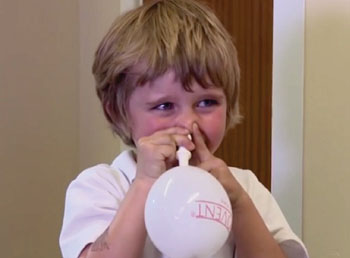Nasal Balloons Treat Otitis Media in Children
By HospiMedica International staff writers
Posted on 13 Aug 2015
A new study suggests that autoinflation of nasal balloons in young children with otitis media with effusion (OME) is effective in clearing effusions and improving symptoms.Posted on 13 Aug 2015
Researchers at the University of Southampton (United Kingdom) conducted an open, pragmatic randomized controlled trial set in 43 family practices in the United Kingdom. Children aged 4–11 years with a recent history of ear symptoms and OME in one or both ears, as confirmed by tympanometry, were allocated to receive either nasal balloon autoinflation three times daily for 1–3 months plus usual care, or usual care alone. Clearance of middle ear fluid at one and three months was assessed by experts masked to allocation.

Image: A child autoinflating a nasal balloon (Photo courtesy of the University of Southampton).
The results showed that of the 320 children enrolled in the study, those receiving autoinflation were more likely than controls to have normal tympanograms at one and three months. Compliance was high, 89% at one month and 80% at three months. The researchers found that nasal balloon autoinflation also produced greater improvements in ear-related quality of life, with adverse events mild, infrequent, and comparable between groups. The study was published on July 27, 2015, in the Canadian Medical Association Journal (CMAJ).
“So many children get glue ear who don't get any treatment. They're not really bad enough to warrant an operation, but it's bad enough to affect their hearing and warrant some medical intervention,” said lead author Ian Williamson, MD. “That pressure that you generate in the nose is sufficient to open up the tube that isn’t really opening properly. It forces air into the middle ear; then the fluid can drain out of it.”
OME is characterized by a nonpurulent effusion of the middle ear that may be mucoid or serous. Symptoms usually involve hearing loss or aural fullness, but typically do not involve pain or fever. In children, hearing loss is generally mild and is often detected only with an audiogram. In general, inpatient care for OME is not required unless complications that threaten the stability of the patient's condition are suspected. A number of medical interventions have been suggested for the treatment of OME, including surgical intervention with pressure equalization tubes (PETs) and adenoidectomy.
Related Links:
University of Southampton













.jpg)
